So, you have a flat tire or one that’s leaking air. It’s not the end of the world. Luckily there are safe and cost-effective ways to properly repair most tire punctures. The purpose of this article is to show you the difference between a safe, permanent repair and a temporary string, plug or patch repair.
According to the National Highway Traffic Safety Administration (NHSTA) and the Tire Industry Association (TIA), the only method to properly repair a tire puncture is to fill the injury with a repair stem and back the stem with a repair patch. This is commonly known as a combination repair or a patch/plug repair.
Patch/plug repairs are most often performed using a one-piece repair unit that combines the repair stem and cap (or patch) into one unit. However, special circumstances may require the use of a two-piece combination repair (ex. If the angle of the puncture exceeds 35 degrees). The repair is then permanently bonded to the inside of tire and through the injury channel using a cold, chemical vulcanizing process.
The repair essentially becomes part of the tire, creating an air-tight seal that keeps air in and moisture and contaminants out (more on this procedure below).
Emergency roadside plug repairs are NOT intended to be a permanent tire repair. Plugs and string repairs are designed to get you back up and rolling long enough to get home or to the nearest service center to perform a proper tire repair.
The common misconception with plug and string repairs is that because they hold air, they are safe to use. While it is true that many plug repairs do a great job of keeping air in the tire, that’s only part of the equation. Because they’re not completely sealing the injury, plug repairs may allow air and moisture to penetrate the body of the tire. Over time, this could lead to a dangerous (or even deadly) blowout.
A Patch-Only Tire Repair Leaves Your Tire Susceptible to DamageA tire repair that uses only a patch is also NOT considered proper or safe.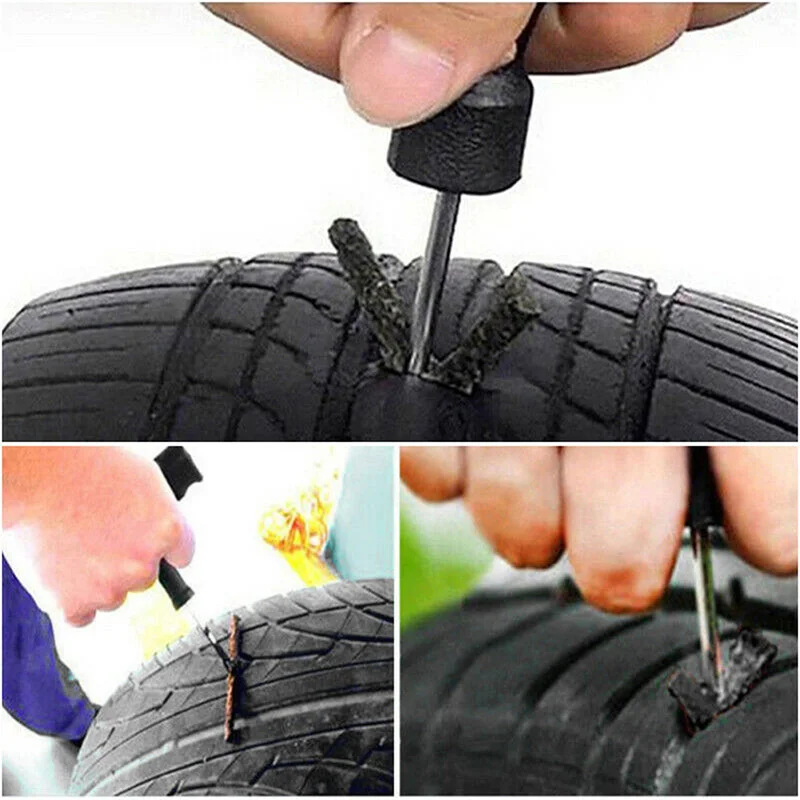 A properly installed patch will do a great job of allowing the tire to hold air. However, similarly to the plug-only repair, the patch does not fill the injury channel. Therefore, air and moisture could seep into the tire from the tread surface and eventually damage the tire.
A properly installed patch will do a great job of allowing the tire to hold air. However, similarly to the plug-only repair, the patch does not fill the injury channel. Therefore, air and moisture could seep into the tire from the tread surface and eventually damage the tire.
Only a proper patch/plug repair completely seals the puncture from inside the tire and through the entire injury channel. There are a few extra steps necessary to perform a proper tire repair in accordance with industry guidelines. We’ve developed a simple acronym to help organize and remember the steps: R.E.P.A.I.R.
 It can also be determined if the puncture did any significant damage to the cords or belts.
It can also be determined if the puncture did any significant damage to the cords or belts. The over-buffed area of the inner liner is treated with a thin layer of rubber sealant, and the excess repair is trimmed to approximately ¼” above the tread surface.
The over-buffed area of the inner liner is treated with a thin layer of rubber sealant, and the excess repair is trimmed to approximately ¼” above the tread surface.There are a number of factors that may determine whether or not your tire is safe to repair. These factors fall into three main categories:
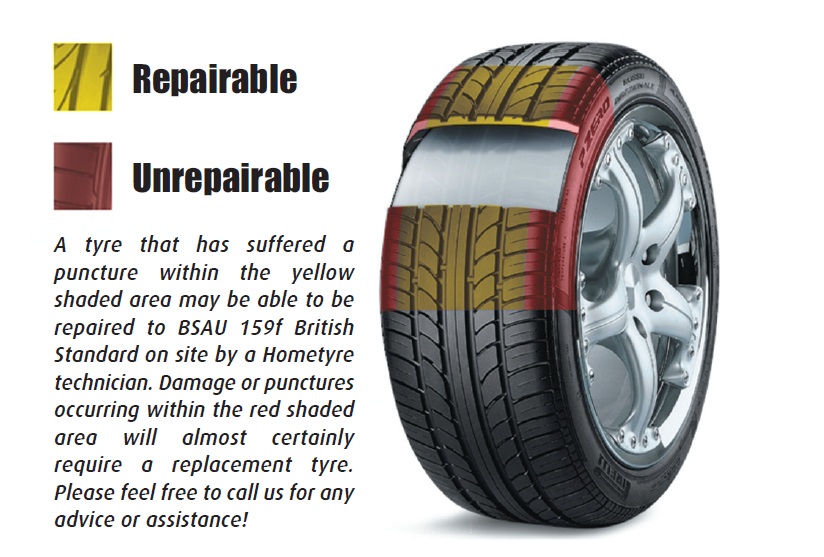 Excessive wear, casing separation, impact damage and other conditions may make it unsafe to properly repair your tire. For a more comprehensive list of repairable vs. non-repairable conditions visit our blog Can Your Tire Be Repaired?
Excessive wear, casing separation, impact damage and other conditions may make it unsafe to properly repair your tire. For a more comprehensive list of repairable vs. non-repairable conditions visit our blog Can Your Tire Be Repaired?The occasional flat or leaky tire is an unavoidable part of life. But, taking shortcuts to repair it can be dangerous to you and your passengers. Take the time and do the research to do the job right and/or find a reputable tire repair shop trained in proper tire repair procedure.
Every editorial product is independently selected, though we may be compensated or receive an affiliate commission if you buy something through our links. Ratings and prices are accurate and items are in stock as of time of publication.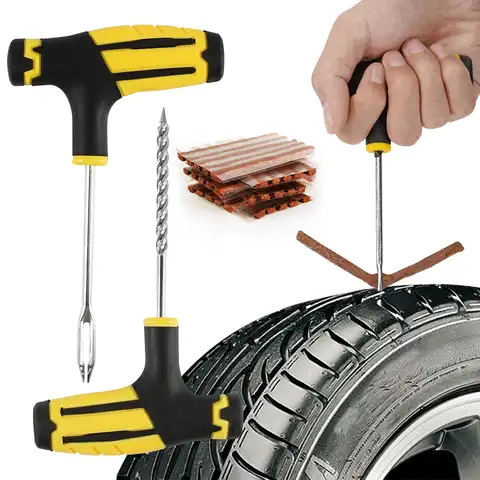
Modern vehicle tires are tough, standing up well to rough terrain and thousands of miles of driving. Trouble is, tires are not invincible. Every so often car tires spring leaks. Air can start leaking from anywhere on a tire, and the location of the leak determines whether or not you can fix it yourself. And if you can't fix it yourself, the location of the leak will also tell you if you need a professional repair or a new tire.
Whether or not your tire is tubed or tubeless affects things, too, because only tubeless tires can be repaired using the technique of plugging that we'll show you here. The good news is that modern vehicles always have tubeless tires, and this means that repairing with a rubber plug is often an option.
Plugging a tubeless tire is only a possibility when your puncture is in the tread area. If the air leak is where the sidewall of the tire meets the rim — this is called a "bead leak" — you'll need to visit a mechanic with a tire machine to dismount the tire from the rim and remount it with sealing liquid applied to the bead. If your sidewall has been punctured, you need a new tire, because damage there can lead to a blowout at highway speeds, even after repair.
If your sidewall has been punctured, you need a new tire, because damage there can lead to a blowout at highway speeds, even after repair.
Learn exactly how to plug a tire so next time you spring a leak between your treads, you'll be able to get up and running again in record time.
Total time completing the repair is about 15 minutes. Doing the work yourself will save you about $20 and the time spent driving to the garage and waiting.
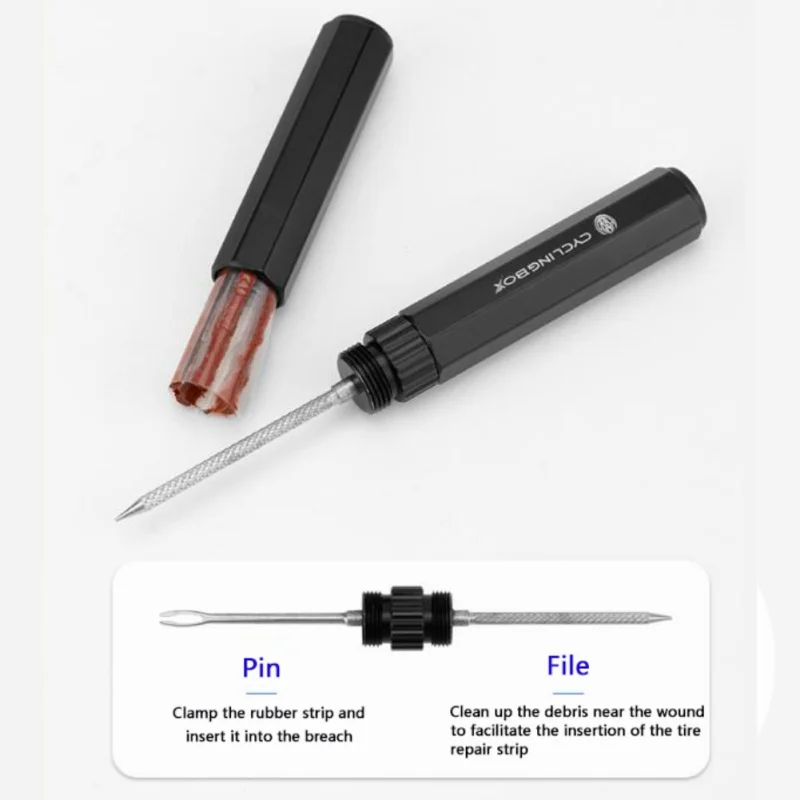
Steve Maxwell for Family Handyman
Complete DIY projects like a pro! Sign up for our newsletter!
Do It Right, Do It Yourself!
Originally Published: August 27, 2020
This helpful tire repair guide describes the basic repair methods for a punctured tyre, tires that cannot be repaired, and problems that can lead to a puncture. There are several repair options available when you hit a nail or other debris that punctures your tire.
A specialist workshop must have everything for tire repair in its arsenal. The quality of the tire repair performed will depend on the quality of the consumables available. For high-quality tire repair, you will need high-quality REMA TIP TOP materials. Everything for repairing REMA TIP TOP tires can be bought on the website https://fenix-market.com/ru/ of the Phoenix-Market company. Over the years of successful activity, Phoenix-Market has established itself in the car service market as a reliable supplier of equipment for service stations and tire fitting, as well as tire repair materials.
The quality of the tire repair performed will depend on the quality of the consumables available. For high-quality tire repair, you will need high-quality REMA TIP TOP materials. Everything for repairing REMA TIP TOP tires can be bought on the website https://fenix-market.com/ru/ of the Phoenix-Market company. Over the years of successful activity, Phoenix-Market has established itself in the car service market as a reliable supplier of equipment for service stations and tire fitting, as well as tire repair materials.
repair, and problems that can lead to a tire puncture.
Tire Repair Options
There are several tire repair options when you hit a nail or other debris that punctures your tire. While all of these repairs cover a puncture, they are not equal in quality, safety, or durability.
 It involves injecting pressurized sealant through the valve stem - just like inflating tires - and allowing the sealant to fill the puncture. Some sealants even have enough bottle pressure to inflate a tire. There are also tire repair kits that include sealant, a portable pump, and other useful tire repair tools. Some new cars even include these kits instead of a spare tire.
It involves injecting pressurized sealant through the valve stem - just like inflating tires - and allowing the sealant to fill the puncture. Some sealants even have enough bottle pressure to inflate a tire. There are also tire repair kits that include sealant, a portable pump, and other useful tire repair tools. Some new cars even include these kits instead of a spare tire. Tire Sealants are for emergency use only and should never be considered a permanent repair. After sealing the tire, immediately go to a repair shop to have the tire inspected and properly repaired or replaced.
When you get to the tire shop, be sure to tell the technician that there is sealant in the tire. Without this warning, the technician could end up with a huge amount of sealant on the floor.
 Then you place the string in a cork tool - a large needle tool - and push it through the hole. Finally, pull out the plug tool slightly—just enough to free it from the plug—and remove the plug tool from the plug, leaving the plug behind.
Then you place the string in a cork tool - a large needle tool - and push it through the hole. Finally, pull out the plug tool slightly—just enough to free it from the plug—and remove the plug tool from the plug, leaving the plug behind. As soon as you drive the car, the heat vulcanizes the rubber and seals the hole. A busbar has several advantages. Firstly, this is a quick repair that does not require dismantling the tires from the wheels. It's also generally cheaper and you can do it yourself in a pinch.
However, a tire plug is not a permanent repair. Plugs are for temporary use only because they tend to leak and can slowly come out of the hole at high speeds. Also, plugs can allow water to seep in and cause rust on the wheels and steel bands that hold the tire in place.
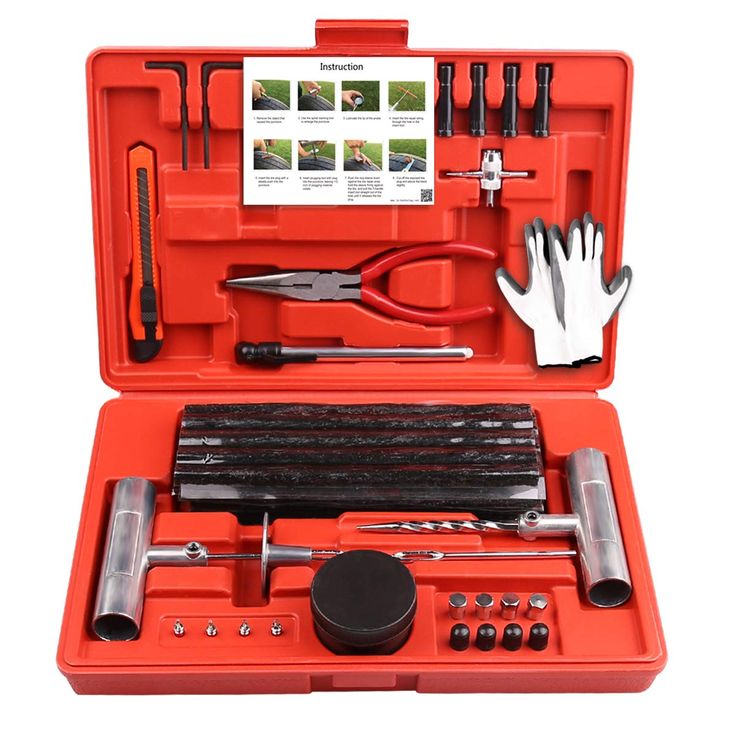 The technician then glues the patch over the puncture, smooths it out with a small roller, and applies the sealant. Due to the self-vulcanizing properties of the tire patch, it will permanently attach to the tire once it has warmed up under normal driving.
The technician then glues the patch over the puncture, smooths it out with a small roller, and applies the sealant. Due to the self-vulcanizing properties of the tire patch, it will permanently attach to the tire once it has warmed up under normal driving. A tire patch is better than a plug because there is no risk of it flying out at high speed. In addition, it creates a more secure seal as it closes the hole and its surroundings. However, patches tend to be more expensive because they take more time and require the technician to balance the tire. The standard patch also does not fill the puncture, which can lead to leakage in the future.
Not every tire puncture can be repaired - patches and plugs have their own design limitations. Here are a few cases where a tire is simply beyond repair.
Large punctures
Regardless of which type of tire fitting you choose - plug or patch - the maximum diameter of a puncture that you can safely repair is 6 mm. Anything larger can cause a leak, which could lead to bigger problems down the road.
Anything larger can cause a leak, which could lead to bigger problems down the road.
Shoulder punctures
All tires have two main tread sections. The tire contact patch is the most central part of the tread between the outer tread channels - circumferential grooves in the tires. The shoulder of a tire is the area between the outermost channels and each sidewall.
The shoulders of the bar not only carry a large load, but also have a slight bend, which makes them unsuitable for patches or plugs. If you have a puncture in your shoulder, the tire is beyond repair, so a new tire is your only option.
Sidewall punctures
The sidewall of a tire—the vertical surface on each side of the tire—is not stiff enough to support a plug or patch. This section flexes and flexes to improve comfort and handling, but this flexing will cause any patch or plug to come loose. For this reason, sidewall punctures cannot be repaired.
Tires with insufficient tread depth
Although you can repair a tire with almost any tread depth, liability is an issue that most auto repair shops take seriously. If they repair a tire with a tread depth of less than 1.6mm and your tire blows out the next day due to low tread, the repair shop could be held liable. Thus, many car services in such cases recommend a new tire.
If they repair a tire with a tread depth of less than 1.6mm and your tire blows out the next day due to low tread, the repair shop could be held liable. Thus, many car services in such cases recommend a new tire.
Special Purpose Tires
While a tire patch works great on most tyres, even winter and high speed tyres, special purpose tires cannot be repaired. These include special racing tires or drag slicks.
Do-it-yourself tire repair - useful tips - magazine Behind the wheel
Is it possible to heal a punctured wheel with the help of a first-aid kit? Za Rulem experts tested 16 kits for repairing tubeless tires in the case, and at the same time demonstrated an operation algorithm for saving a damaged tire. The instructions are supplemented by life hacks that will be useful to all drivers.
Once you find a puncture, prepare the compressor.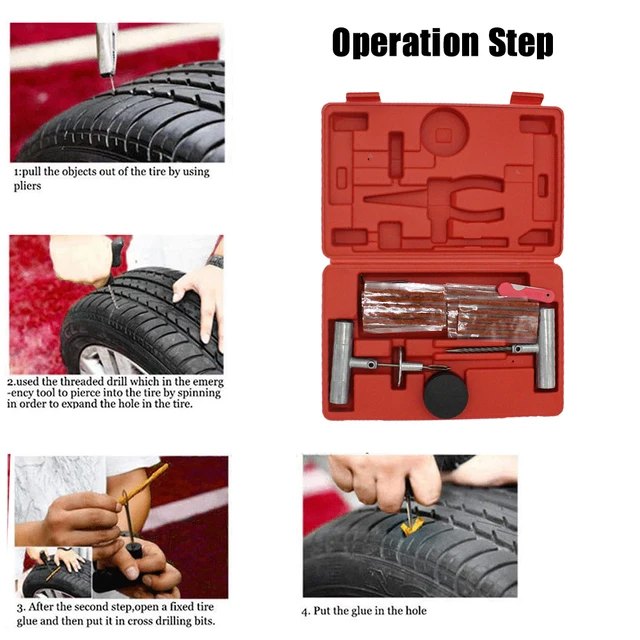 If by all means you have to go, you will hold out for a while. If you are going to repair, remember: under pressure it is easier to find the puncture site. And easier to repair.
If by all means you have to go, you will hold out for a while. If you are going to repair, remember: under pressure it is easier to find the puncture site. And easier to repair.
Once you find a puncture, prepare the compressor. If by all means you have to go, you will hold out for a while. If you are going to repair, remember: under pressure it is easier to find the puncture site. And easier to repair.
In ancient times, there was GOST 5170-73 "First-aid kits for the repair of pneumatic tires". What components were not in these first-aid kits! And a fungus, and a grater with a band-aid, and a roller ... And now each manufacturer decides for himself what exactly to put in his kit.
Let's check what the descendants of those first-aid kits are capable of. The editorial of Grant pushed him to decisive action, one of the wheels of which expired. Instead of a tire fitting, we visited several shops where we purchased 16 different tubeless tire repair kits. The price spread is sevenfold, although the principle of operation is the same.-web.jpg) After detecting a puncture, you need to remove the culprit of the trouble (a self-tapping screw, a nail), then expand the hole and firmly insert a folded rubber flagellum into it. The nuances of technology and tools may differ, but in general, the repair algorithm is exactly the same.
After detecting a puncture, you need to remove the culprit of the trouble (a self-tapping screw, a nail), then expand the hole and firmly insert a folded rubber flagellum into it. The nuances of technology and tools may differ, but in general, the repair algorithm is exactly the same.
Related materials
Having repaired a tire that a self-tapping screw met on the road, we decided to test all 16 repair kits on the poor thing. However, in the end, only 13 stab wounds were inflicted on her, since three sets were rejected at once: the flagella in them are frankly bad, instantly torn in the hands.
The instruments also differ quite a lot. So, the cute handle in the CityUp CA-793 set managed to turn around relative to the sting at the first attempt to get inside the tire.
Note that some kits do not provide any "pickers", and in some places there is no glue. And almost all manufacturers have different names of tools - in the explanations we give exactly the "branded" version.
| Pickers of various colors. More convenient are those with a T-shaped handle. It is better if the working part has the form of a square-section rod twisted in a spiral. A rod with a diamond-shaped knurling is slightly worse, and very badly serrated - it tears the cord. Ideally, the tool should simply spread the cords. "Pickers" of various stripes. More convenient are those with a T-shaped handle. It is better if the working part has the form of a square-section rod twisted in a spiral. A rod with a diamond-shaped knurling is slightly worse, and very badly serrated - it tears the cord. Ideally, the tool should simply spread the cords. | |
| "Needle" with different handles. The most convenient is the T-shape. The working end must be sharp and have an eyelet with rounded edges. "Needle" with different handles. The most convenient is the T-shape. The working end must be sharp and have an eyelet with rounded edges. | Bundles in the left side are fit, reinforced. But nothing good can be said about the rest of the products: they are torn even when you try to insert them into the ear. Harnesses on the left side - fit, reinforced. But nothing good can be said about the rest of the products: they are torn even when you try to insert them into the ear. |
A tire with this many holes in the tread part passed the test at 100 speeds for a couple of weeks without losing a drop of precious air. For the sake of the experiment, we did not even cut off a few ponytails - and everyone held on. A small puncture in the sidewall was also managed with the help of a flagellum. Although the reliability of sealing is noticeably lower than in the case when the tourniquet is held in a thick (even for a used tire) tread layer.
Do not understand where the air is siphoning from? A water procedure will help detect a leak. Do you not understand where the air is siphoning from? A water procedure will help detect a leak. | The tire sidewall can be easily pierced with an ordinary kitchen knife. A cut one and a half centimeters wide is, generally speaking, a sentence for a tire, but you have to get there! The sidewall of the tire can easily be pierced with an ordinary kitchen knife. A cut one and a half centimeters wide is, generally speaking, a sentence for a tire, but you have to get there! |
Auto Tire Repair Tool Kit for Tubeless Tires for Quick Puncture Auto Tire Repair Block Repair | |
Attention: We don't ship glue due to shipping restrictions!!!
Features:
1. Tire repair cost is low, it can save more than 90% cost.
2. Fast tire repair: The whole process of tire repair with this tire repair tool takes about 3-5 minutes, while traditional tire repair takes about 30 and a half minutes, saving time.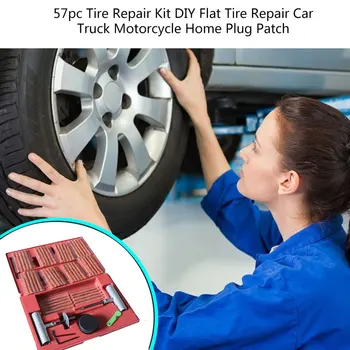
3. Small tire restrictions: no time and place restrictions, they can be repaired anytime, anywhere, when a tire is broken, you can repair your own tires.
4. Simple operation. There are no technical requirements and most people can operate it, which is much easier than the traditional tire repair method.
5. Long use time: tires filled with tire repair tools can be used for 1-2 years and are safe and reliable.
Descriptions:
This product is simple and convenient to operate, which can reduce the cost of car daily maintenance.
This kit contains all tire tempering tools and is suitable for all types of tires.
Specifications:
Color: color mixing
Material: iron + plastic
Use range: all vacuum tires
Notes:
1. Due to the difference between different monitors, the picture may not reflect the actual color of the item. We guarantee the style is the same as shown in the pictures.
2. Please allow slight size difference due to different manual measurements.
Packing List
1 x Car Tire Repair Kit
,
Car Motorcycle Tire Repair Quick Repair Tool Kit Tubeless Sealing Strips Tire Repair Tire Puncture Tools | |
Description:
100% brand new and high quality
Excellent adhesion, wear resistance and durability, long service life
Suitable for repairing car vacuum tires for motorcycles
Can be used on all types of tubeless tires
No glue needed
Indispensable for cars with tubeless tires, this car tire repair kit will quickly and effectively repair a puncture, and in a few minutes you'll be on the road again
Purchased to meet the needs of repeated use, not because of repeated purchases and waste of money
Easy to use and easy to install.
Excellent tire repair tool, easy to fix a puncture.
Help avoid the inconvenient change of road type.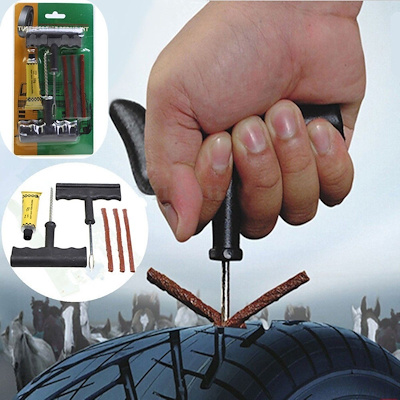
Super professional and long time use.
Material: butyl rubber
Colour: as shown
Thickness: approx. 6mm
Length: approx. 10cm
Quantity: 5 pcs. / Set
How to use:
A mark is made on the puncture site, and an object has been punctured on the pulled out spot.
Use of a tire probe proved a broken hole. Penetrating direction, along the insertion direction of the punch hole, to clean the broken hole debris from dust.
The end of the tape cut into the slanted neck is worn into the opening of the hole so that both ends of the tape have the same length.
Pin along the broken hole, insert the tires, make sure the tape is inserted 2/3 of the length (need to determine the wear of the tape in the body of the tire, avoid slipping after inflating the tape), turn the pin 360 degrees and remove the pin.
Remaining tire tapes, 5 mm tape the rest is cut off.
Specifications:
Suitable for repairing vacuum tires for motorcycles, cars.
Can be used for all kinds of tubeless tires
No glue needed
Easy to use and easy to install.
Excellent tire repair tool, easy to fix a puncture.
Help avoid the inconvenient change of road type.
Package includes:
5 pcs. / Kit Tire strips
.
Car Tire Repair Kit Auto Motorcycle Tubeless Vacuum Tire Repair Patch Kit for Universal Car Accessories | |
Product Description:
Color: as picture
Type: Tire repair tools
Quantity: 1 set
Weight: 0.16kg
Features:
1.Easily repairs punctures without removing the tire from the rim. Tire plugs are vulcanized onto your existing tire, which is the least expensive and most effective means of repairing a puncture.